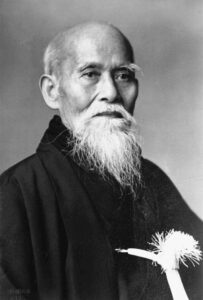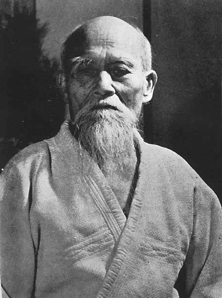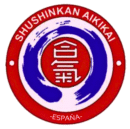O’Sensei
Born in Tanabe, Wakayama Prefecture, Japan on December 14, 1883, Morihei Ueshiba became interested in martial arts from a very early age.
His father was a well-known peasant, and his mother came from a noble family (descended from samurai). Ueshiba Sensei spent most of his youth engaged in religious studies, which contributed to his lifelong interest in spiritual matters. His father had him study sumo, and later, around 1902, he began his studies in the arts of jujutsu (hand-to-hand combat) and kenjutsu (sword wielding).
He returned to his father's house after being released from military service in 1907. During this time, he studied judo. In 1912, he led a group of pioneers to the northern island of Hokkaido to establish a village and farm the land. They founded the village of Shirataki (which still exists) with over 80 people. Around this time, he began his studies in Daito-ryu. He graduated as a teacher after diligently following the practice under the guidance of his teacher, the prestigious Sokaku Takeda.
In 1919, he was informed that his father was seriously ill. While traveling to his father's home, he met Onisaburo Degushi, leader of the Shinto sect known as Omoto-Kyo. Mr. Deguchi had a profound influence on the young Ueshiba with his religious teachings and concepts. After his father's death, he returned to Mr. Deguchi and established a martial arts academy in his home where he taught members of the Omoto-Kyo. During this time, religious teachings began to have a profound influence on him. Morihei Ueshiba saw a connection between spirituality and physical movement, and his teachings began to change. After a time, many people began to believe that there was a "great master" of martial arts in the village.
Together with Mr. Deguchi, Ueshiba traveled to Manchuria and Mongolia with the aim of establishing a "sacred land." It didn't work out, and upon returning from the heart of Asia, he continued his studies of kenjutsu and jujutsu and began studying sojutsu (spear technique).
In the spring of 1925, he met a naval officer who was an expert in kenjutsu and challenged Ueshiba Sensei. When attacked by the officer, he was able to evade any blows thrown. After this experience, while fighting, he had a vision. In it, he saw a "golden light," as he put it, surrounding him. He then understood the unity of the Universe and the principles from which he developed the concepts of Aikido. From this, he understood that he should call his art aiki-budo (the martial path of Aiki) instead of aiki-jutsu (the techniques of Aiki).
In 1927 he established his residence in Tokyo after several stays there with the purpose of teaching some government officials and officials of the Emperor's Court.
Between 1941 and 1942, O'Sensei (Grandmaster), as he is known, decided to call his art Aikido (The Way of Harmony) and retired to a farm in the countryside to continue his religious studies and the practice and perfection of his art. He began building a shrine and a training facility. In 1964, he received the Order of the Rising Sun, 4th Class, as the Founder of Aikido.
Ueshiba gave his final demonstration in January 1969 and died on April 26 of that year. His ashes were interred in Kozanji, Tanabe, and he was named an honorary knight of Tanabe and Iwama.




